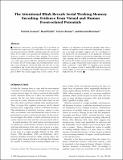The Attentional Blink Reveals Serial Working Memory Encoding: Evidence from Virtual and Human Event-related Potentials
Author(s)
Craston, Patrick; Wyble, Brad; Chennu, Srivas; Bowman, Howard
DownloadCraston-2009-The Attentional Blink Reveals Serial Working Memory Encoding.pdf (368.6Kb)
PUBLISHER_POLICY
Publisher Policy
Article is made available in accordance with the publisher's policy and may be subject to US copyright law. Please refer to the publisher's site for terms of use.
Terms of use
Metadata
Show full item recordAbstract
Observers often miss a second target (T2) if it follows an
identified first target item (T1) within half a second in rapid serial
visual presentation (RSVP), a finding termed the attentional
blink. If two targets are presented in immediate succession,
however, accuracy is excellent (Lag 1 sparing). The resource
sharing hypothesis proposes a dynamic distribution of resources
over a time span of up to 600 msec during the attentional blink.
In contrast, the ST2 model argues that working memory encoding
is serial during the attentional blink and that, due to joint
consolidation, Lag 1 is the only case where resources are shared.
Experiment 1 investigates the P3 ERP component evoked by targets
in RSVP. The results suggest that, in this context, P3 amplitude is an indication of bottom–up strength rather than a measure of cognitive resource allocation. Experiment 2, employing
a two-target paradigm, suggests that T1 consolidation is
not affected by the presentation of T2 during the attentional
blink. However, if targets are presented in immediate succession
(Lag 1 sparing), they are jointly encoded into working memory.
We use the ST2 model’s neural network implementation, which
replicates a range of behavioral results related to the attentional
blink, to generate ‘‘virtual ERPs’’ by summing across activation
traces. We compare virtual to human ERPs and show how the
results suggest a serial nature of working memory encoding as
implied by the ST2 model.
Date issued
2009-03Department
Massachusetts Institute of Technology. Department of Brain and Cognitive SciencesJournal
Journal of Cognitive Neuroscience
Publisher
MIT Press with the Cognitive Neuroscience Institute
Citation
Craston, Patrick et al. "The Attentional Blink Reveals Serial Working Memory Encoding: Evidence from Virtual and Human Event-related Potentials." Journal of Cognitive Neuroscience 21:3, pp. 550–566. © 2009 The MIT Press.
Version: Final published version
ISSN
0898-929X
1530-8898